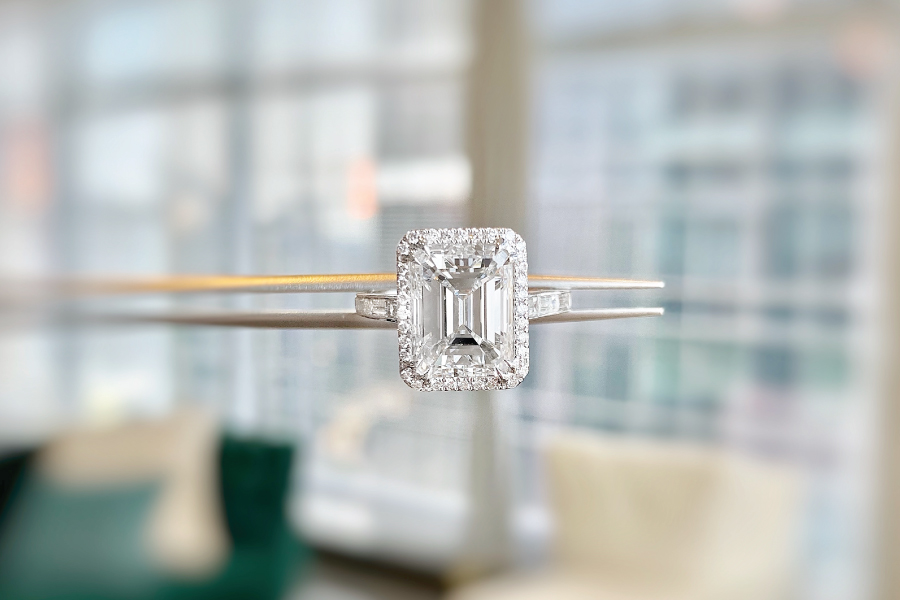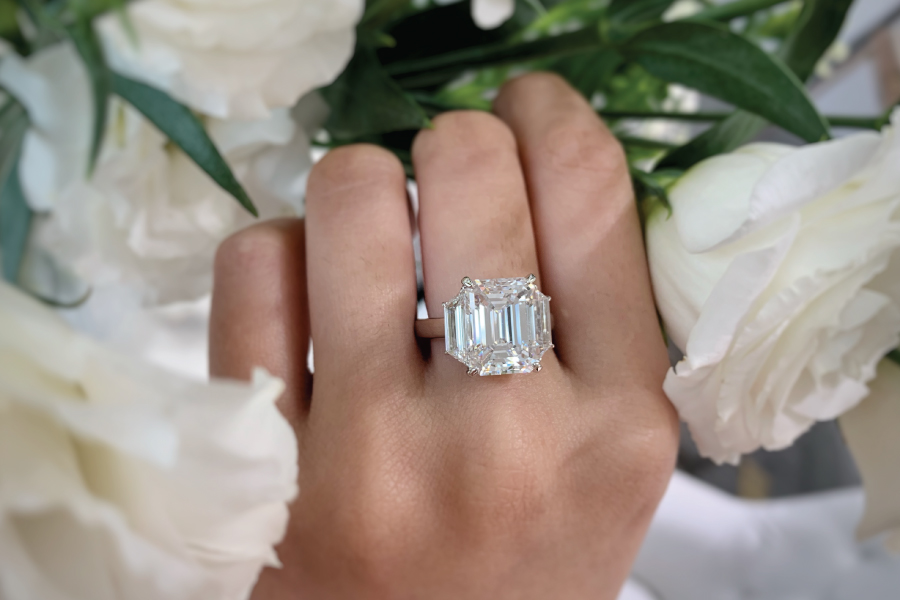If you are shopping for an engagement ring - whether that ring is an emerald cut diamond engagement ring, a yellow diamond engagement ring or one of the many other beautiful options available, one of the (many) choices you will need to make is the type of metal your diamond - or gemstone if you prefer - is set in.
This is more complicated than many people expect, as while they might think they know about gold, they quickly find out that’s maybe not the case, especially when it comes to understanding the different gold types and weights that will be discussed.

An amazing diamond ring
Gold Basics
First, a word on pure gold...
It's a yellowish, thick, and flexible precious metal in its purest form.
Of all the metals, it is the most malleable.
It can be found as a nugget or a grain in rocks, veins, or alluvial deposits in its natural state.
The majority of gold discovered is thought to have resulted from asteroid collisions with the Earth around 4 billion years ago.
It's one of the least reactive chemical elements, solid at room temperature, and resistant to most acids.
At the moment, China is the world's foremost gold producer, with artisanal or small-scale mining accounting for around a quarter of global gold production.
Gold has been utilized as currency, jewelry, and in the arts throughout history.
Gold purity is measured in Karats (K). 24-carat gold is considered pure gold.
White Gold vs. Yellow Gold vs. Rose Gold
One of the first decisions you’ll make when it comes to the metal for your diamond engagement ring is usually between one of these three golds. You could also choose platinum, but that’s a more expensive choice and perhaps not on the cards for you.

A perfect diamond ring
If you are ‘going for gold’ understanding the basic differences between white gold, yellow gold and rose gold should help you make the right choice, both for your personal taste and to ensure that the diamond, fancy colored diamond, emerald, sapphire or other gemstone you have in mind is showcased as beautifully as possible.
It's all about the alloy you mix with pure gold.
All jewelry gold is alloyed with other metals to increase its hardness, as pure gold is very soft and would be completely unsuitable for daily - or even occasional - wear. So, the alloys used are what create the differences between the types of gold used to help create the perfect diamond engagement ring.
Yellow Gold — Gold is naturally "yellowish" in hue and is unaffected by tarnish, rust, or corrosion under normal conditions. However, as previously stated, it is still alloyed with some base metals to provide sturdiness when used in jewelry construction. The more "yellow" a piece of gold is, the purer it is, but it will be less durable. The majority of jewelry is made of 18K or 14K gold.
White Gold - This is 24K gold that has been alloyed with "white" base metals like silver, palladium, nickel, and occasionally zinc. The amount of alloy added to white gold determines its karat grade and, as a result, its final hue. White gold is more durable than yellow gold, but it retains a yellowish tint. To produce the appearance of being fully "white," a piece of jewelry may be coated in a platinum-based metal known as rhodium plating.
Its only significant flaw is that it isn't hypoallergenic, and some people may be allergic to certain alloys. This problem can be solved by plating the piece in rhodium.
Rose Gold - Rose gold is 24K gold that has been alloyed with copper. The karat rating of rose gold, and hence its final color, is determined by the amount of copper added. Because copper is so robust, rose gold, or Russian gold as it was previously known, is the most durable of all. Rose gold, like white gold, can cause allergic reactions in certain people since copper is not hypoallergenic.
By the way, while these are the three gold types most commonly used for diamond engagement rings, there are other gold types, and, for those looking to have a custom diamond engagement ring created, they may be worth knowing about:
Black Gold – Gold plated using black rhodium
Blue Gold – Gold alloyed with iron.
Green Gold – Gold alloyed with silver.
Purple Gold – Gold alloyed with aluminum.

What About Karats?
Another thing that many people find a little confusing is gold karat weight. Most people assume that the higher the number, the better. However, it’s not quite that simple. 24K will be very soft and very yellow, unless it is alloyed with another metal, as we just discussed. And so many 18K gold rings will be more durable, something that it’s important to consider when discussing a ring that will almost certainly be worn almost every day, which is the idea behind a diamond engagement ring!

Is White Gold Best for Diamond Engagement Rings?
White gold has certainly become the most popular choice for engagement rings today, but that is more about trends and fashion than anything else. Up until the late 1980s in the West, yellow gold was a far more common choice.
There is a lot to be said for a white gold engagement ring. It is the metal that looks most like the more expensive platinum, it matches well with any outfit or manicure because it’s very neutral, and it usually enhances clear diamonds beautifully.
However, it really is a matter of personal choice. The one thing you will need to remember is that white gold will yellow over time. Some people are upset by this process, as they think it means that their ring is tarnishing! That’s not the case however, it means that the ring probably needs a new rhodium plating, which your jeweler can provide.
If you are choosing a darker stone, an emerald for example, yellow gold may do a better job of enhancing its vibrant color than white gold.
And who might pick rose gold? Rose gold has a very delicate, warm color that almost has an antique vibe in the 21st century. Once very fashionable, it fell out of favor for some time, but is regaining popularity with those who want their diamond engagement ring to stand out from the crowd.






